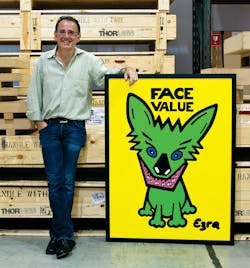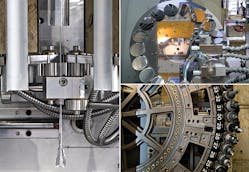OSA: What got you interested in optics?
Alex Cable: It was purely accidental. I got a late start academically, and at 28 was finishing my undergraduate degree in physics at Rutgers when Steve Chu visited the campus and mentioned he needed a technician. The years I spent working at Bell Labs for him and later for Mara Prentiss (now at Harvard) made me realize the great impact photonics could have on the world.
I have benefited from strong mentors. My first was a Ukranian, Oleg Kreofsky, who taught me drafting and mechanical design. Then a Hungarian, Alex Karoly, taught me machining and rebuilding huge machine tools that were several decades old and had no instructions. I learned to get into the designer's mind by taking apart a complex machine and fitting it back together.
Like them, Steve was a master in his field. Working with him and Mara in a small group that also included Art Ashkin and Leo Hollberg helped shape my life. I learned that I had the capacity to continually learn, and that gave me the confidence to introduce an ever-expanding array of new technologies to Thorlabs (see figure).OSA: What drew you away from research?
AC: I always wanted to have my own business. The first inklings came when I was 10 and went door to door selling sketches by my older sister, who was a very skilled artist. It was pretty lucrative for a kid—I kept half the money.
My parents were beatniks who encouraged intellectual pursuits, but practiced benign neglect. We had few rules, no structure, and near-total self-reliance, which provided me with a unique approach to business. I left school at 16 and spent six months hitchhiking around the country. Then, I started working and learning about life. Oleg told me to dress appropriately and polish my shoes. I've always enjoyed hard work, so I worked at a restaurant as well, starting as a dishwasher and working up to sous chef under the guidance of head chef Joe Scrudato. In my mid-20s, I thought of opening a restaurant, but had an intellectual awakening and went back to school to educate myself. I learned a lot at Bell Labs, and Steve encouraged me to move to Stanford with him, but the attraction of starting my own business was just too strong.
OSA: How would you compare the rewards of the lab and of business?
AC: It's the same to me. Working in the lab to assess the scientific, societal, and environmental potential of a new field or updating our business strategy are both fabulous, good fun. Success in business can have an impact well beyond the direct contributions of research publications. Each of the roughly 4000 packages we ship each day is a tangible reminder of our impact—I can't imagine a greater reward.
Ever since my restaurant experience, I have been looking to reproduce the intensity and excitement of a Saturday evening with over 100 reservations in the book. You knew you could never prepare as well as you would like to and that you had to make choices with limited time. The intensity was invigorating—it was full engagement. You had to learn not to let perfection get in the way of good preparation, while still striving to serve perfection to the customer. It's the same in any business.
OSA: What has helped Thorlabs scale up and grow so successfully?
AC: Amazingly good luck, focus on profitable growth to fuel the future, balancing risky projects with safe ones, and re-investing essentially all our profits back in the business.
Commercializing science requires deep expertise throughout Thorlabs. Surprisingly, scientific invention almost takes care of itself, as there always seems to be more potential opportunities than bandwidth. The biggest challenge is to maintain the proper manufacturing infrastructure and scale it as new opportunities arise. It takes a large appetite for risk. Being privately owned lets us take the long view, 10 years or more out. Our cash flow limits our growth, forcing us to make hard choices on where we invest—this limited funding ensures we pay due respect to each dollar we invest, which I believe boosts the performance of the investments that make the cut.
To keep pace with rapidly changing markets, I periodically live the life of a customer, from ordering products to unpacking and using them. Our customers are research and industrial scientists and a broad range of manufacturers, and we need to know their diverse needs and expectations.
I also stay tuned in to the research community at conferences like CLEO because that's where tomorrow's great ideas emerge. For my business to remain healthy over the long term, we need close contact with the people who are inventing the future.
OSA: What stimulates you about optics and photonics?
AC: Photonics has vast opportunities to contribute to many applications. From the potential for early disease detection by spectroscopic analysis of human breath to down-hole oil-well monitoring and gravitational wave detection, it's all amazingly stimulating.
Much of my time now goes into advanced imaging technology for brain research and improved cancer treatment. We have about 80 people in Sterling, VA, developing new imaging platforms and participating in the White House BRAIN [Brain Research through Advancing Innovative Neurotechnologies] Initiative. I'm also excited by the prospects of using mid-infrared spectroscopic analysis of breath to spot diseases early on. Other possibilities include robotic vision systems, quantum computing, and frequency-comb based environmental sensors. Our field constantly spawns new opportunities, so we have to stay tuned to the needs of our core research customers.
I also have outside investments. One of them is Boston MicroMachines, whose micromirror technology is used in adaptive optic systems that search for planets around other stars. Advanced photonics are central to the search for "Goldilocks" planets just right for life, which is a huge scientific quest.
The business overall needs to be profitable, but it's so much bigger than just running a profitable business. There's a certain multiplier that comes from having aspirational goals. The BRAIN Initiative is a great example of where there's so much opportunity for new knowledge, and so much that new knowledge can bring to us.
OSA: Where do you see photonics technology going in the long term?
AC: Ultimately, a Dyson Sphere. I'm a big Star Trek fan, and that's a far-out concept of an extremely advanced civilization that captures all the energy from its sun.
I say that somewhat tongue-in-cheek, but it is a way of saying how I view our world. The photonics community is comprised of builders who build knowledge that leads to building things. I'd like my life to have meaning, so I strive to contribute to building meaningful technology that enriches all lives.
I'm an optimist, and ultimately I believe that we can do good with technology. Talking about a Dyson Sphere implies that we will conquer the mega-problems that challenge our world, from global hunger to environmental disruption that might even threaten to collapse our civilization. We are fast approaching a point where I expect we will have no choice but to rely on massive technological fixes. Photonics can help stave off that day, as well as contribute some of the potential fixes.
ALEX CABLE is president and chief executive officer of Thorlabs, which he founded in the basement of his Newton, NJ home in 1989. He named the company after a Labrador retriever named Thor, and still paints "edgy" dogs for company promotions. Thorlabs now has 1500 employees, annual sales of about $350 million a year, and divisions around the globe. Cable is a fellow of The Optical Society.
The Optical Society celebrates a century of innovation
Throughout a century of breakthroughs, The Optical Society has brought together the best minds in optics and photonics to light the future. This series reflects on that history and looks to what innovations lie ahead. For more information, please visit http://osa.org/100.

